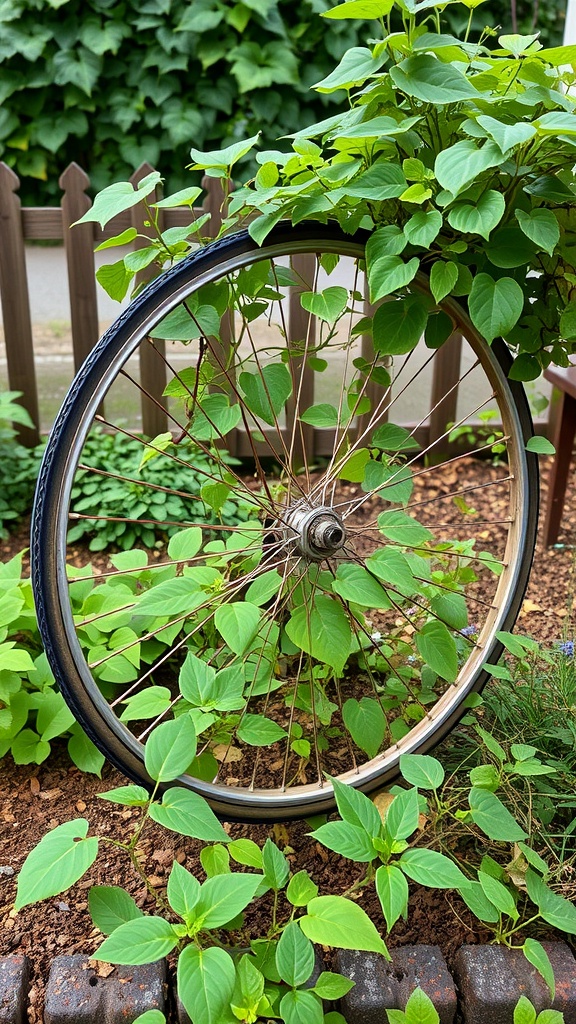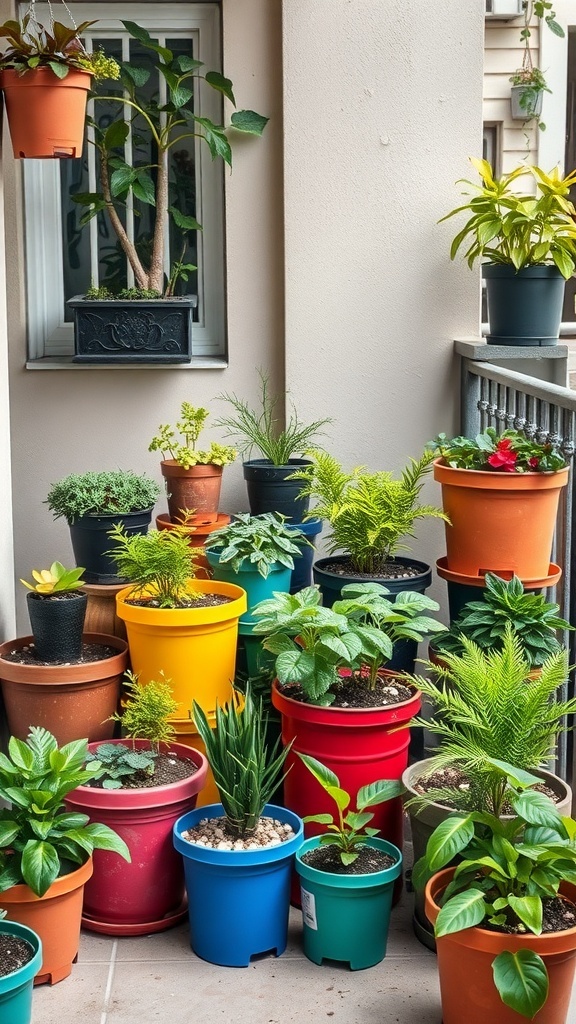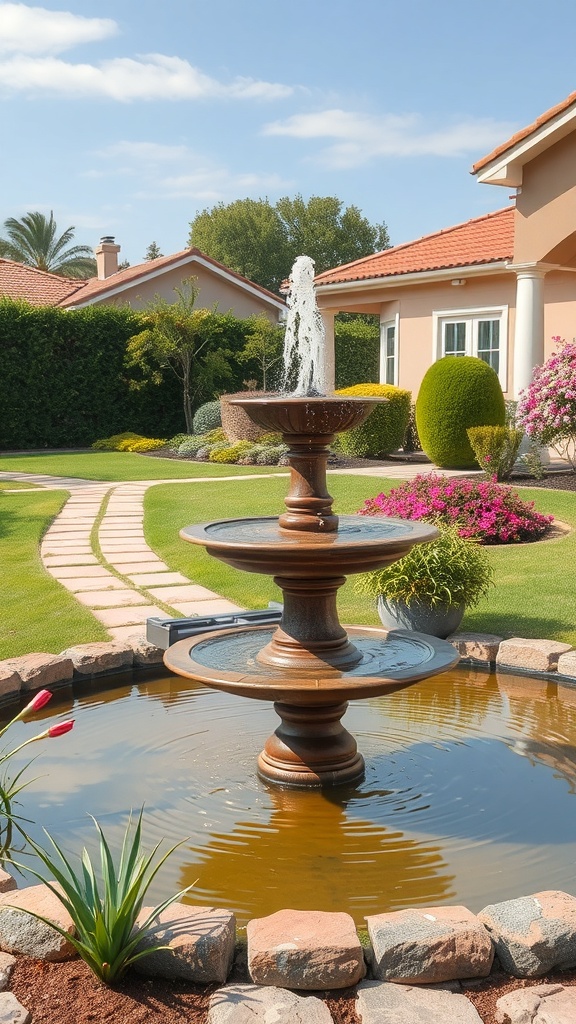33 Creative Tree Stump Planter Ideas for Your Garden
Tree stump planters are a fun and eco-friendly way to repurpose those unsightly stumps in your yard! Instead of digging them out, give them new life by transforming them into charming planters. Fill them with vibrant flowers, herbs, or even succulents, and watch your garden come alive with nature’s art. It’s a simple, stylish, and sustainable solution that adds character to any outdoor space!
Creating Drainage Holes in the Stump

When turning a tree stump into a planter, creating drainage holes is a key step. This ensures that excess water can escape, preventing root rot and keeping your plants healthy.
In the image, you can see a drill being used to make a hole in the center of a tree stump. This tool is perfect for creating the necessary drainage. You want to make several holes at the bottom of the stump to allow for proper water flow.
Start by marking where you want the holes. A good rule of thumb is to space them evenly. Then, carefully drill into the stump, making sure to go deep enough to create a pathway for water to drain out.
After drilling, check the holes to ensure they are clear. You might want to use a small stick or a wire to remove any debris. This simple step can make a big difference in the health of your plants.
Incorporating Decorative Elements

Using a tree stump as a planter opens up a world of creative possibilities. This image showcases a charming arrangement that combines natural elements with decorative touches. The stump itself serves as a rustic base, adding character to any garden space.
In the center, you’ll find a delightful mix of small plants and stones. The vibrant greens of the plants contrast beautifully with the earthy tones of the stump. Adding pebbles in different colors not only enhances the visual appeal but also helps with drainage.
Lighting is another fun element to consider. The glowing orbs on branches bring a warm, inviting feel to the arrangement. They can create a cozy atmosphere during evening gatherings. Candles placed around the plants add a soft glow, making the space feel magical.
Don’t forget to personalize your stump planter! You can include small figurines or decorative stones that reflect your style. This makes the planter not just a home for plants, but a unique piece of art in your garden.
Designing a Layered Planting Scheme

Using a tree stump as a planter can create a unique focal point in your garden. The image shows a tree stump filled with vibrant green plants, showcasing how nature can reclaim space. This layered planting scheme adds depth and interest to your outdoor area.
Start by choosing plants of varying heights and textures. In the photo, the bright yellow and deep green leaves contrast beautifully, making the arrangement eye-catching. Consider using trailing plants to soften the edges of the stump, allowing them to cascade over the sides.
Mix in some seasonal flowers for pops of color. This not only enhances the visual appeal but also attracts pollinators. Think about the light conditions in your garden when selecting plants to ensure they thrive.
Don’t forget to maintain the stump itself. Regularly check for moisture and health of the plants. This approach not only beautifies your space but also promotes a sustainable gardening practice.
Selecting Suitable Plants for Stump Planters
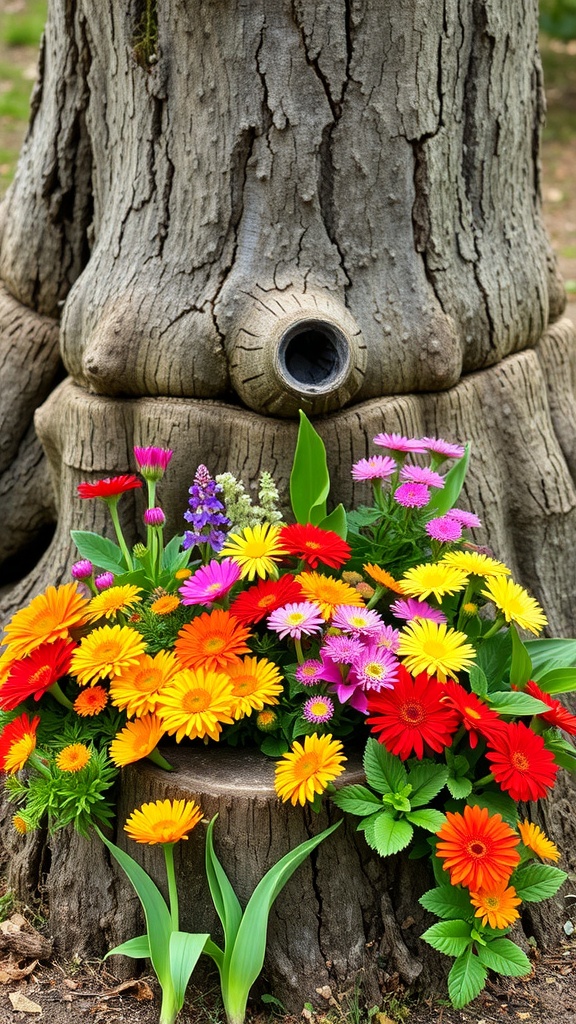
Using tree stumps as planters can add a unique touch to your garden. The image shows a beautifully arranged display of colorful flowers around a tree stump. This setup not only looks great but also makes use of what might otherwise be waste.
When choosing plants for stump planters, consider the amount of sunlight the area receives. Some flowers thrive in full sun, while others prefer partial shade. In the image, the bright gerbera daisies and other vibrant blooms suggest a sunny spot, perfect for cheerful colors.
Another factor is the size of the stump. Smaller stumps can accommodate smaller plants, while larger stumps can hold a variety of flowers. Mixing different types can create a lovely layered effect, just like in the photo.
Don’t forget about the soil! Ensure it’s well-draining and rich in nutrients. Adding compost can help your plants flourish. The lush greenery in the image hints at healthy soil conditions.
Lastly, think about the season. Some flowers bloom in spring, while others might be summer favorites. Choosing a mix can keep your stump planter looking fresh throughout the year. With a little thought, your stump planter can become a vibrant focal point in your garden.
Soil Mixture for Optimal Growth
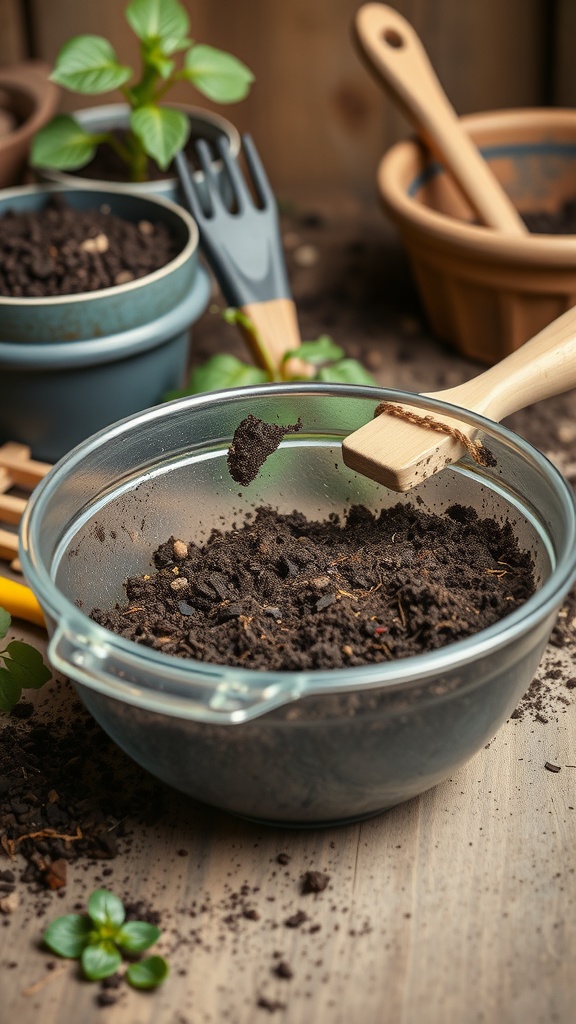
Creating a tree stump planter is a fun way to add greenery to your space. The right soil mixture is key to helping your plants thrive. In the image, you can see a bowl filled with rich, dark soil, ready to be used for planting.
Start with a base of high-quality potting soil. This provides a good foundation for your plants. Mixing in some compost will give your soil a nutrient boost. Compost is great for improving soil structure and providing essential nutrients.
Don’t forget to add perlite or vermiculite. These materials help with drainage, ensuring that your plants don’t sit in water. A well-draining soil mixture is crucial for healthy root development.
Finally, consider adding a slow-release fertilizer. This will feed your plants over time, giving them the nutrients they need to grow strong. With the right soil mixture, your tree stump planter will flourish!
Preparing the Stump for Planting

Transforming a tree stump into a planter is a fun and creative project. The first step is to prepare the stump properly. In the image, you can see someone using a tool to hollow out the center of the stump. This is essential for creating space for soil and plants.
Start by removing any loose bark and debris from the stump. This helps to prevent pests and diseases from affecting your plants. Once the surface is clean, use a chisel or a similar tool to carve out the inside. Aim for a depth that allows enough room for roots to grow.
After hollowing out the stump, check for any signs of rot. If the wood is too decayed, it might not support the plants well. You can also add a layer of gravel at the bottom for drainage. This will help keep the roots healthy and prevent water from pooling.
Finally, fill the hollowed-out area with good quality potting soil. This will give your plants the nutrients they need to thrive. With the stump ready, you can now choose your favorite flowers or herbs to plant!
Maintaining Moisture Levels in the Stump

Using a tree stump as a planter is a creative way to add charm to your garden. The image shows someone watering a stump filled with soil, which is crucial for keeping your plants happy and healthy.
To maintain moisture levels in your stump planter, start by ensuring that the stump has good drainage. If water collects at the bottom, it can lead to root rot. You can add small stones or gravel to the bottom before filling it with soil.
Regular watering is key. Check the soil moisture by sticking your finger in the soil. If it feels dry an inch below the surface, it’s time to water. A watering can, like the one in the image, is perfect for this task.
Consider the type of plants you choose. Some plants prefer more moisture, while others thrive in drier conditions. Grouping plants with similar water needs can make your watering routine easier.
Lastly, mulching can help retain moisture. Adding a layer of mulch on top of the soil not only keeps it moist but also adds a nice touch to your stump planter. With these tips, your tree stump planter can flourish!
Choosing the Right Tree Stump

When picking a tree stump for your planter, size matters. Look for a stump that’s big enough to hold the plants you want. A larger stump can accommodate more soil and roots, giving your plants a better chance to thrive.
Check the condition of the stump too. You want one that’s healthy and free from rot. A solid stump will provide a sturdy base for your planter. If you see cracks or signs of decay, it’s best to skip that one.
Consider the shape of the stump. Some have a more natural, rustic look, while others might be more uniform. Think about how it will fit into your garden design. A unique shape can add character to your space.
Lastly, think about the location. Make sure the stump gets enough sunlight for the plants you choose. A spot that’s too shady might not work well for sun-loving plants.
Dealing with Pest Issues in Stump Planters

Using a tree stump as a planter is a creative way to repurpose an old tree. However, it can attract pests that might harm your plants. In the image, a person is carefully adding soil to a stump planter, showing how to set up a beautiful green space.
Pests like ants, beetles, and even slugs can find their way into stump planters. To keep them at bay, start by ensuring your stump is dry and free from rot. Wet wood can attract unwanted visitors.
Another tip is to use natural pest deterrents. Sprinkling diatomaceous earth around the base can help keep crawling pests away. You can also introduce beneficial insects like ladybugs, which eat aphids and other harmful bugs.
Regularly check your plants for signs of pests. Early detection can save your plants from serious damage. If you spot any, remove them by hand or use a gentle soap solution to wash them off.
Lastly, keeping your stump planter well-maintained will help. Trim any dead leaves and ensure your plants are healthy. Healthy plants are less likely to attract pests, making your gardening experience more enjoyable.
Creative Stump Planter Arrangements

Tree stump planters bring a unique charm to any garden. They add a rustic touch while serving as functional plant holders. In the image, you can see various stump planters filled with vibrant flowers and greenery. Each stump has its own character, showcasing the natural beauty of wood.
The arrangement is playful, with stumps of different heights and sizes creating visual interest. Some stumps are topped with succulents, while others hold colorful blooms. This mix of plants adds life and color to the space, making it inviting and cheerful.
In the background, you can spot a lovely house and whimsical sculptures, enhancing the overall aesthetic. This setting encourages creativity in using natural materials for gardening. Whether you have a large yard or a small patio, incorporating tree stumps can transform your outdoor area into a delightful retreat.
Seasonal Care for Stump Planters

Tree stump planters can bring a unique charm to your outdoor space, especially during the festive season. This image showcases a beautifully decorated stump planter, adorned with snowflakes, greenery, and festive ribbons. It’s a perfect example of how to elevate your garden decor.
As the seasons change, so does the care your stump planter needs. In winter, it’s important to protect the plants from harsh weather. Consider wrapping the planter with burlap or adding mulch to insulate the roots. This helps keep the soil temperature stable.
During the spring, check for any signs of rot on the stump. If the wood is deteriorating, it might be time to replace it. Refresh the soil and add new plants that thrive in warmer weather. Bright flowers can really make your stump planter pop!
Summer care involves regular watering, especially if the weather is dry. Ensure the plants are getting enough sunlight but also provide some shade if they seem to be wilting. Adding a layer of decorative stones can help retain moisture and enhance the look.
In the fall, you can transition your stump planter to a seasonal display. Incorporate autumn leaves, small pumpkins, or even festive lights. This keeps your outdoor space lively and engaging throughout the year.
Using Stump Planters for Edible Plants

Tree stump planters are a fun and creative way to grow edible plants. The image shows a charming tree stump filled with vibrant greens and colorful vegetables. This setup not only looks great but also makes use of a natural resource that might otherwise go to waste.
Growing herbs and vegetables in a stump can be quite rewarding. The stump provides a unique aesthetic while offering a sturdy base for your plants. In the picture, you can see fresh herbs alongside small, colorful peppers. These plants thrive in the rich, organic material that can be added to the stump.
To start your own stump planter, choose a healthy stump and hollow it out a bit. Fill it with quality soil and plant your favorite herbs or vegetables. Some great options include basil, mint, or even small peppers. Make sure to water them regularly and watch them flourish!
Combining Stump Planters for a Garden Feature
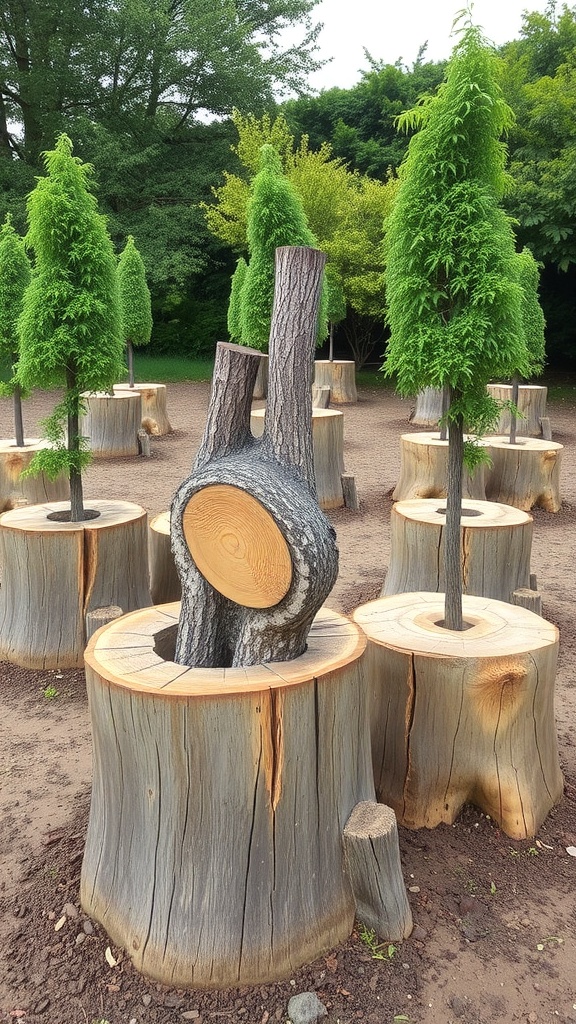
Tree stump planters can really add character to your garden. They turn old, unused tree stumps into beautiful displays of greenery. In the image, you can see several stumps, each with a young tree growing from the center. This creates a unique and natural look.
Combining different sizes and shapes of stumps can enhance the visual appeal. You can arrange them in a way that draws the eye and creates a focal point. The varying heights of the stumps in the image add depth and interest to the space.
Using stump planters is also a great way to repurpose materials. Instead of tossing out old stumps, you can give them new life. This not only helps the environment but also adds a rustic charm to your garden.
Consider planting flowers or herbs in some stumps for a pop of color. Mixing greenery with vibrant blooms can create a lively atmosphere. You can also use mulch around the stumps to keep the area tidy and enhance the overall look.
Repurposing Old Stumps into Planters
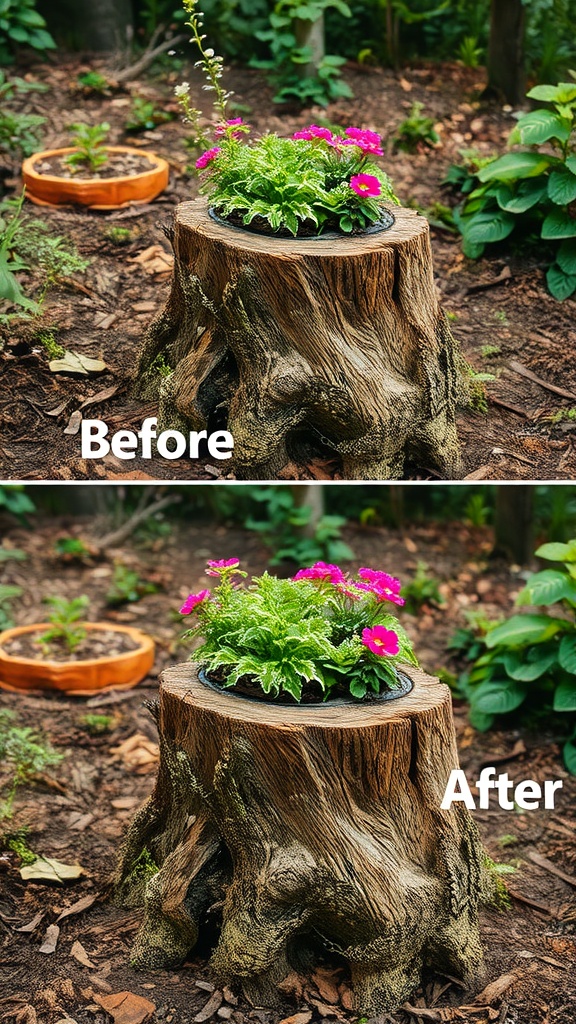
Turning an old tree stump into a planter is a fun and creative way to breathe new life into your garden. The image shows a transformation from a simple stump to a vibrant planter filled with colorful flowers. This not only enhances the beauty of your outdoor space but also gives a unique touch to your garden.
To start, you can choose a stump that’s already in your yard or find one that needs a new purpose. The key is to hollow out the top of the stump, creating a space for soil and plants. You can use a drill or a chisel for this task. Once the stump is ready, fill it with potting soil and add your favorite flowers or plants.
The after image showcases how a little effort can turn a dull stump into a lively focal point. The bright pink flowers pop against the natural wood, making it a charming addition to any garden. This project is not only eco-friendly but also a great way to express your gardening style.
Repurposing stumps into planters is a simple DIY project that anyone can try. It’s a great way to recycle and add character to your garden. So grab your tools, pick some plants, and let your creativity flow!
Incorporating Wildlife-Friendly Features

Transforming a tree stump into a planter not only adds charm to your garden but also creates a welcoming space for wildlife. The image showcases a beautifully arranged planter filled with vibrant flowers, attracting butterflies and other pollinators.
Choosing native plants for your stump planter is a great way to support local wildlife. These plants are adapted to the environment and provide food and shelter for various creatures. The colorful blooms in the image are likely to entice butterflies, making your garden a lively spot.
Adding features like small rocks or twigs around the planter can create habitats for beneficial insects. These little details help foster a balanced ecosystem in your garden. The stump itself serves as a natural perch for birds and insects, enhancing the wildlife-friendly aspect.
By incorporating these elements, you not only beautify your space but also contribute to the health of your local environment. It’s a simple yet effective way to make your gardening efforts more impactful.
